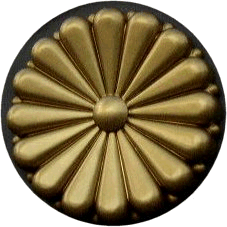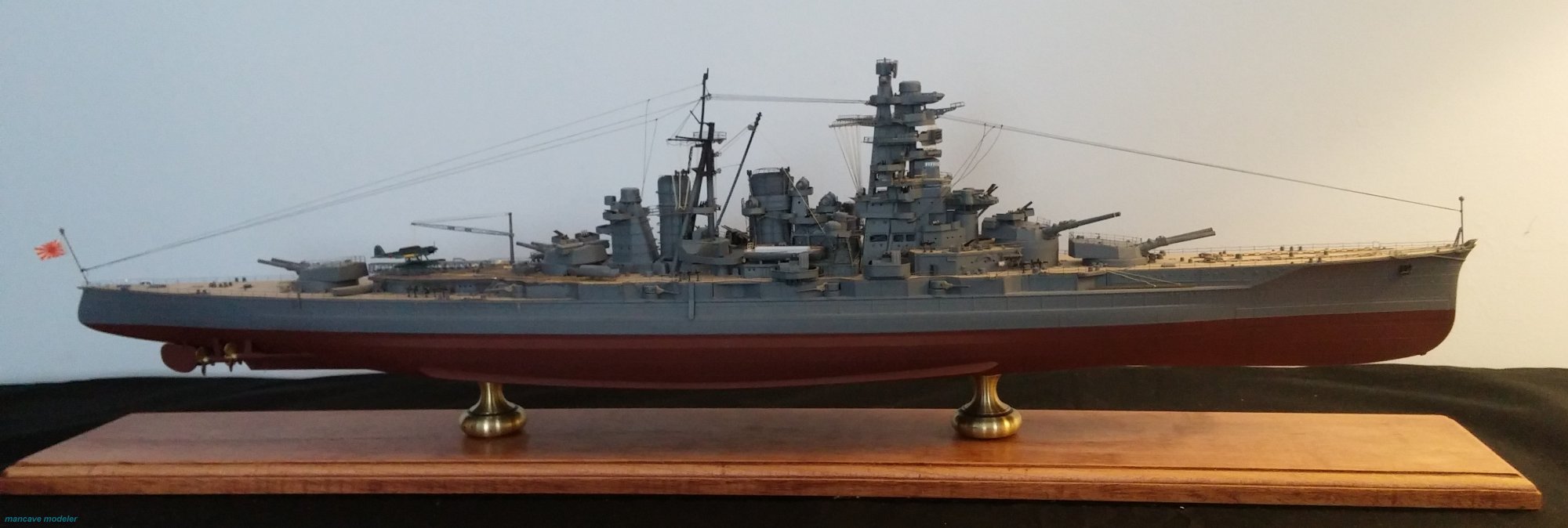Laid down in 1911 in Britain by Vickers Shipbuilding Company. Kongo was the last Japanese capital ship constructed outside Japan. She was formally commissioned into the Japanese Navy on August 16, 1913 and arrived in japan in November 1913
After the outbreak of WW1, Kongo patrolled along the Chinese coast and participated in the capture of German posessions in the Carolines, Palau, Marianas and the Marshall Islands.
After the Armistice in 1918, Kongo served with various divisions within the Japanese fleet, and on several occasions embarked Crown Prince Hirohito accompanied by Prince Hiroyoshi Fushimi for visits to several Japanese Colonies in the Pacific.
|
First Reconstruction, September 1929
Unable to build new battleships under the terms of the Washington Naval Treaty, Kongo and her sisters were converted to Battleships. The thickness of her armor was improved and torpedo blisters were added to the hull. Her boilers were replaced and equipment was mounted to accommodate three Type 90 floatplanes. With the addition of the new boilers, her profile changed as one of her funnels and her torpedo tubes were removed.
At the end of March 1931, most of the work was done and she was reclassified a Battleship
During then next four years, Kongo had several improvements to her range finders and defensive capabilities.
June 1, 1935 through January 8, 1937: Second reconstruction:
No longer encumbered by the former Washington and London Treaty restrictions, KONGO is reconstructed into a fast battleship, capable of escorting Japanese fleet carriers. Her stern is lengthened and her bridge is rebuilt pagoda style. All boilers are are removed and replaced with eight oil-fired boilers and she receives new geared turbines. Her speed is increased to 30 knots.
Kongo's main belt was strengthened to a uniform thickness of eight inches and diagonal bulkheads of depths ranging from 5 to 8 inches were added to reinforce the main armored belt. The turret armor was strengthened to 10 inches, while 4 inches were added to portions of the deck armor. The ammunition magazine protection was also strengthened to 4.0 inches
A catapult and rails for three floatplanes are installed between her No. 3 and 4 turrets. She now carries Nakajima E8N1 Type 95 and Kawanishi E7K1 Type 94 floatplanes.
The elevation of KONGO's main armament is increased from 33 degrees to 43 degrees. and her secondary armament is increased from 15 degrees to 30 degrees. Her Torpedo tubes and 40-mm MGs were removed and ten twin 25-mm MGs installed along with a 10M rangefinder atop her pagoda.
War Service
November 29, 1941,
Accompanied by sister ship Haruna, the Kongo sortied from the Hashirajima fleet anchorage as part of the Southern (Malay) Force's Main Body, under the overall command of Vice-Admiral Nobutake Kondo. Arriving on December 4, 1941, off the coast of southern Thailand and northern Malaya in preparation for the invasion of Thailand and the Malay Peninsula
December 9, 1941
The hunt and destruction of British Force Z
The Main Body, southeast of Indochina near Poulo Condore Island sorties south for a night attack against Force Z centered around Prince of Wales and Repulse, but no contact is made. December 10th, joined by Cruisers and Destroyers, the Main Body begins the search for the british fleet off Malaysia. Upon recieveing news that both battleships have been sunk, the Japanese foerces withdraws top Camranh Bay in French Indochina (modern day Viet Nam).
From Mid December through Mid February 1942, Kongo participated in most of the Japanese naval operations throughout the Southwest Pacific, covering further invasions of malaysia, Luzon at the Lingayan Gulf.
In late February 1942, the Kongo was joined by the Haruna, four fast aircraft carriers, five heavy cruisers and support ships in preparation for "Operation J", Japan's invasion of the Dutch East Indies. On 25 February, the Third Battleship Division provided cover for air attacks on the Island of Java. On 7 March 1942 The Kongo bombarded Christmas Island off the western coast of Australia before returning to Staring-baai and going on stand-by
April 1942,
the Kongo joined five fleet carriers in attacks on Colombo and Trincomalee on Ceylon. Following the destruction of the British heavy cruisers HMS Dorsetshire and HMS Cornwall, and the carrier HMS Hermes on April 5, 1942, this naval task force moved southwest to locate the remainder of the British Eastern Fleet, then under the command of Admiral James Somerville. On April 9, one of Haruna's reconnaissance seaplanes spotted the HMS Hermes south of Trincomalee. On the same day, Japanese air attacks sank the carrier, and the Kongo was attacked by British bombers but was undamaged. Having crippled the offensive capability of Britain's Eastern Fleet, the Third Battleship Division returned to Japan. The Kongo reached Sasebo on April 22nd. and the Kongo was drydocked until May 2nd
May 1942,
Kongo sortied with the Hiei and four Cruisers as part of Admiral Kondo's invasion force during Operation MI, the Battle of Midway.
Following the loss of four of the Combined Fleet's fast carriers on 4 June 1942, Kondo's force withdrew to Japan.
In August, Kongo was drydocked at Kure to receive new radar and additional range finders. In September, Kongo embarked with the Hiei, the Haruna, the Kirishima, three carriers, and numerous smaller warships to counter the U.S. Marine Corps's amphibious landing on Guadalcanal in the Solomon Islands. On 20 September, this task force was ordered to return to the Truk Naval Base.
|
|
| Namesake: | Mount Kongo |
| Ordered: | 1911 |
| Builder: | Vickers Shipbuilding Company, Barrow-in-Furness |
| Laid down: | 17 January 1911 |
| Launched: | 18 May 1912 |
| Commissioned: | 16 August 1913 |
| Struck: | 20 January 1945 |
| Fate: | Sunk by USS Sealion in the Formosa Strait,
November 21, 1944 |
General characteristics |
| Class: | Kongo class battlecruiser |
| Displacement: | 36,600 long tons (37,187 t) |
| Length: | 222 m (728 ft 4 in) |
| Beam: | 31 m (101 ft 8 in) |
| Draught: | 9.7 m (31 ft 10 in) |
| Propulsion: | Steam turbines, 4 shafts |
| Speed: | 30 knots (35 mph; 56 km/h) |
| Range: | 10,000 nmi (19,000 km) at 14 kn (26 km/h) |
| Complement: | 1360 |
| Sister ships | 4 |
| Hiei | Launched, November 21, 1912,
Sunk, Naval Battle of Guadalcanal, Nov. 13, 1942 |
| Kirishima | Launched, December 1, 1912,
Sunk, Naval Battle of Guadalcanal, Nov. 13, 1942 |
| Haruna | Launched, December 14, 1912,
Sunk by US aircraft, July 28, 1945
Broken up for scrap, 1946 |
Armament: |
| 1913: |
| 8 356 mm (14 in) naval guns (4×2) |
| 16 152 mm (6.0 in) naval guns (16×1) |
| 8 76 mm (3 in) naval guns (8×1) |
| 4 6.5 mm (0.26 in) machine guns |
| 8 submerged 533 mm (21.0 in) torpedo tubes |
| 1944: |
| 8 356 mm (14 in) naval guns (4×2) |
| 8 152 mm (6.0 in) naval guns (8×1) |
| 8 127 mm (5 in) guns (4×2) |
| 122 25 mm (0.98 in) Type 96 Antiaircraft autocannons |
| Armor: |
| deck: | 2.3–1.5 in (58–38 mm)
(later strengthened +101mm on ammo storage, +76mm on engine room) |
| turrets: | 9 in (230 mm) |
| barbettes: | 10 in (250 mm) |
|






